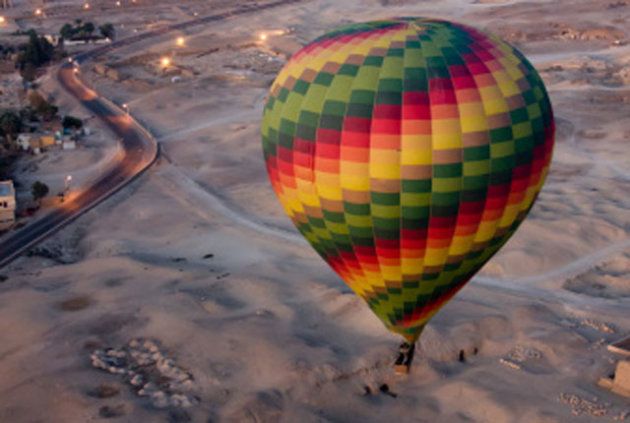
A hot air balloon flying over Egypt's ancient city of Luxor has caught fire and crashed into a sugar cane field, killing at least 18 foreign tourists, a security official says.
It was one of the worst accidents involving tourists in Egypt and likely to push the key tourism industry deeper into recession. The casualties included French, British, Japanese nationals and nine tourists from Hong Kong, the official said.
Three survivors of the crash — two tourists and one Egyptian — were taken to a local hospital.
According to the Egyptian security official, the balloon carrying at least 20 tourists was flying over Luxor when it caught fire, which triggered an explosion in its gas canister, then plunged at least 300 metres from the sky.
It crashed into a sugar cane field outside al-Dhabaa village just west of Luxor, 510 kilometres south of Cairo, said the official, speaking on condition of anonymity because he was not authorised to talk to the media.
Bodies of the dead tourists were scattered across the field around the remnants of the balloon. An Associated Press reporter at the crash site counted eight bodies as they were put into body bags and taken away. The security official said all 18 bodies have been recovered.
The official said foul play has been ruled out. He also said initial reports of 19 dead were revised to 18 as confusion is common in the aftermath of such accidents.
Two survivors, including the balloon’s pilot, have been taken to hospital, a security official told news agency AFP.
Tourism official Ahmed Aboud said the balloon was at around 1,000 feet above Luxor, famous for its pharaonic temples and tombs of the Valley of the Kings when the blast happened, which Aboud said was caused by an explosion in the hose between the balloon's burner and its gas canister.
Mohamed Mustafa, a doctor at the hospital where the wounded were being treated, said the dead included tourists from Britain, Japan and Hong Kong. Three more were hurt, he added.
Luxor province's governor told Al Jazeera Mubasher Misr that some of the bodies had yet to be identified.
Photographer Christopher Michel was in another balloon, taking some aerial shots, at the time of the crash.
He told the BBC: "We flew over the ancient ruins. Just before landing in the cornfields, I heard an explosion and saw smoke. I think it was the balloon behind mine.
"I wasn't sure what had happened at first. It was only when we landed we heard the full extent of what happened." In Hong Kong, a travel agency said nine of the tourists that were aboard the balloon were natives of the semiautonomous Chinese city. It did not say whether all nine were killed. The information was posted on the agency's website.
U.S. photographer Christopher Michel, who was on board another balloon, told Britain's Sky News television that the balloon was one of eight flying at the time.
"We heard a loud explosion behind us. I looked back and saw lots of smoke. It wasn't immediately clear that it was a balloon," he said.
In Paris, a diplomatic official said French tourists were among those involved in the accident, but would give no details on how many, or whether French citizens were among those killed.
Speaking on condition of anonymity because he wasn't authorised to be publicly named according to government policy, the official said French authorities were working with their Egyptian counterparts to clarify what happened. French media reports said two French tourists were among the dead but the official wouldn't confirm that.
A New Zealand Ministry of Foreign Affairs and Trade spokesman said its consular staff in Egypt were aware of the reported crash near Luxor. They were working to find out if any New Zealanders were involved.
Hot air ballooning, usually at sunrise over the famed Karnak and Luxor temples as well as the Valley of the Kings, is a popular pastime for tourists visiting Luxor.
The site of the accident has seen past crashes. In 2009, 16 tourists were injured when their balloon struck a cellphone transmission tower. A year earlier, seven tourists were injured in a similar crash.
Egypt's tourism industry has been decimated since the 18-day uprising in 2011 against autocrat leader Hosni Mubarak and the political turmoil that followed and continues to this day.
Luxor's hotels are currently about 25 per cent full in what is supposed to be the peak of the winter season.
Hot air ballooning at dawn is a popular draw with tourists, a mainstay of the Egyptian economy, but visitor numbers have fallen sharply since a 2011 uprising that toppled veteran President Hosni Mubarak. Two years of political instability have scared off many foreign tourists.
Tourism accounted for more than a 10th of Egypt's gross domestic product before the revolt. In 2010, around 14.7 million visitors came to Egypt, but this slumped to 9.8 million people the next year.
Tuesday 26 February 2013
http://www.stuff.co.nz/auckland/local-news/national-news/8355080/Egypt-hot-air-balloon-crash-kills-18-tourists
http://news.yahoo.com/hot-air-balloon-carrying-20-tourists-crashes-egypt-063653885.html

0 comments:
Post a Comment